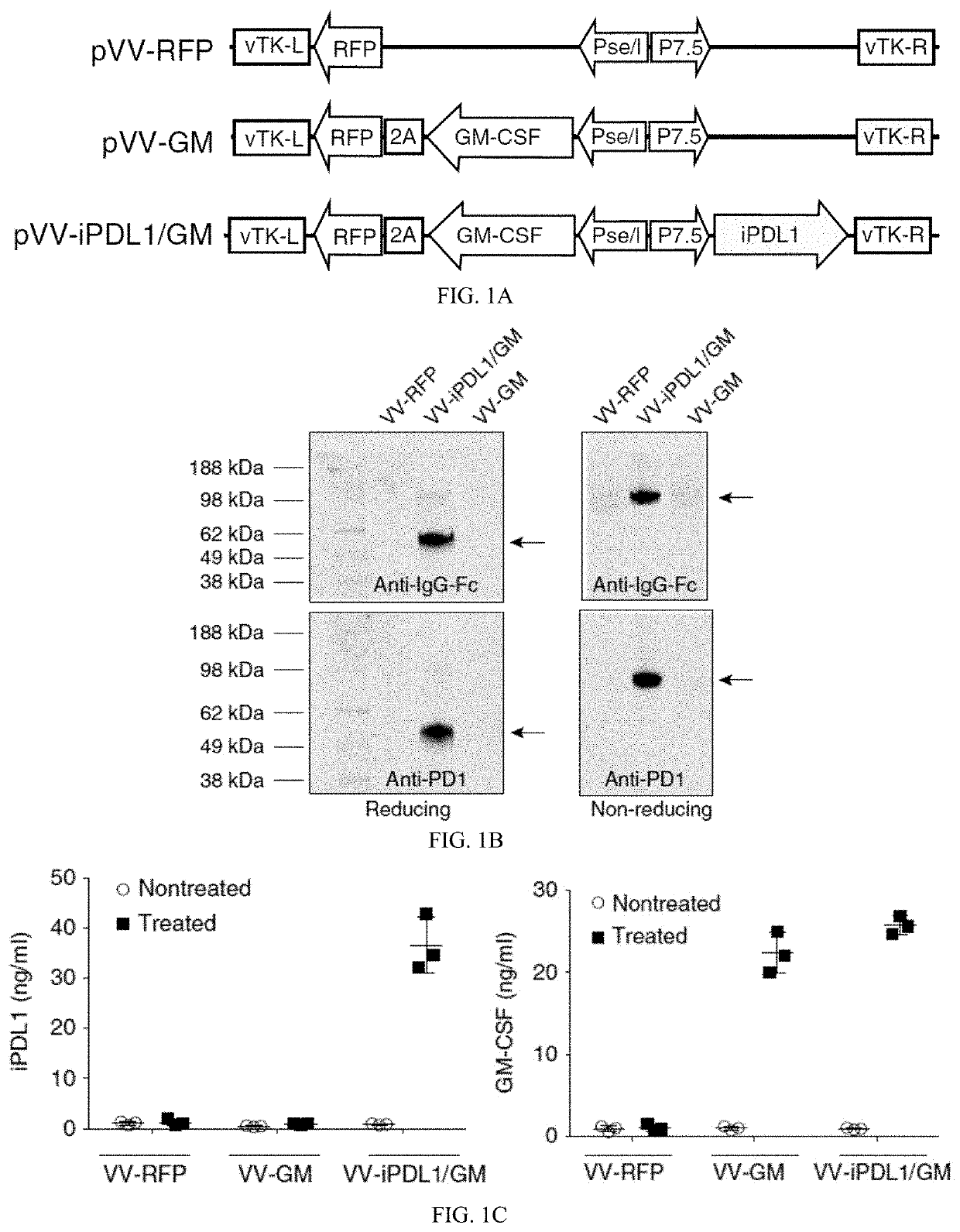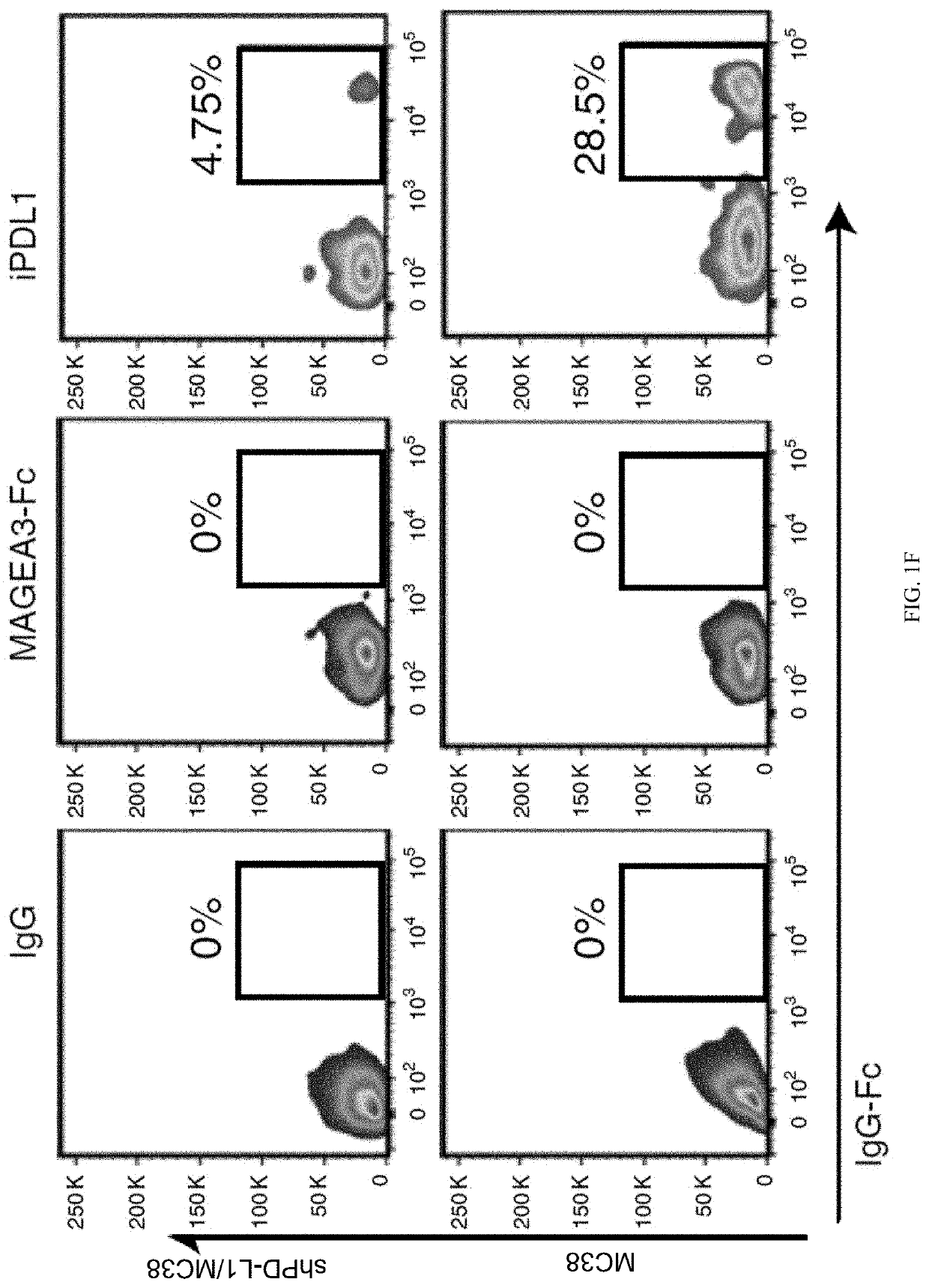Engineered oncolytic viruses expressing pd-l1 inhibitors and uses thereof
a technology of oncolytic viruses and inhibitors, applied in the field of anti-cancer therapies, can solve the problems of poor mhc presentation, poor capacity to attract t cell infiltration, and patients still fail to spontaneously activate neoantigen-specific t cells, so as to reduce the severity of cancer
- Summary
- Abstract
- Description
- Claims
- Application Information
AI Technical Summary
Benefits of technology
Problems solved by technology
Method used
Image
Examples
example 1
1.1 Generation and Characterization of an Armed Oncolytic Vaccinia Virus (VV) Coexpressing a PD-L1 Inhibitor and GM-CSF (VV-iPDL1 / GM).
[0111]We generated an engineered oncolytic VV coexpressing a murine soluble PD-1 extracellular domain fused with IgG1 Fc as a PD-L1 inhibitor (i.e., iPDL1) and murine GM-CSF (VV-iPDL1 / GM), in the backbone of a tumor-selective double-deleted oncolytic VV, in which thymidine kinase (TK) and vaccinia growth factor viral genes had been deleted (FIG. 1A). A recombinant oncolytic VV-GM expressing murine GM-CSF and a recombinant oncolytic VV-RFP expressing the marker ref fluorescent protein (RFP) were also generated and produced. High levels of both GM-CSF and iPDL1 (soluble PD-1-IgG Fc) proteins in a dimer were produced and efficiently released from VV-iPDL1 / GM-infected tumor cells in vitro and in vivo, as detected by western blot and enzyme-linked immunosorbent assay (ELISA; FIGS. 1B-1D, 1K). Importantly, high levels of iPDL1 were detected in the sera of V...
example 2
Preclinical Study of an Engineered Oncolytic Vaccinia Virus Co-Expressing a Human PD-L1 Inhibitor and Human GM-CSF
2.1 Generation and Characterization of a Recombinant Oncolytic Vaccinia Virus Coexpressing Human PD-L1 Inhibitor and GM-CSF (VV-ihPDL1 / GM).
[0161]A recombinant vaccinia virus shuttle vector pVV-ihPDL1Fc / GM that coexpresses human PD1-Fc fusion protein (ihPDL1) controlled by the vaccinia virus Pse / 1 promoter or / and human GM-CSF by the vaccinia virus p7.5 later early promoter was constructed. Control shuttle vectors, pVV-RFP that only expresses RFP marker controlled by the vaccinia virus Pse / 1 promoter and pVV-GM that only expresses human GM-CSF, were also constructed (FIG. 1A). CV-1 cells were infected with vaccinia virus growth factor (vgf)-deficient vaccinia virus vSC20 and then co-transfected with one of the recombinant shuttle plasmids for homologous recombination. PCR assays were performed to select the recombinant viruses that have the transgenes at the tk locus of va...
PUM
| Property | Measurement | Unit |
|---|---|---|
| volume | aaaaa | aaaaa |
| volume | aaaaa | aaaaa |
| volume | aaaaa | aaaaa |
Abstract
Description
Claims
Application Information
 Login to View More
Login to View More - R&D
- Intellectual Property
- Life Sciences
- Materials
- Tech Scout
- Unparalleled Data Quality
- Higher Quality Content
- 60% Fewer Hallucinations
Browse by: Latest US Patents, China's latest patents, Technical Efficacy Thesaurus, Application Domain, Technology Topic, Popular Technical Reports.
© 2025 PatSnap. All rights reserved.Legal|Privacy policy|Modern Slavery Act Transparency Statement|Sitemap|About US| Contact US: help@patsnap.com



